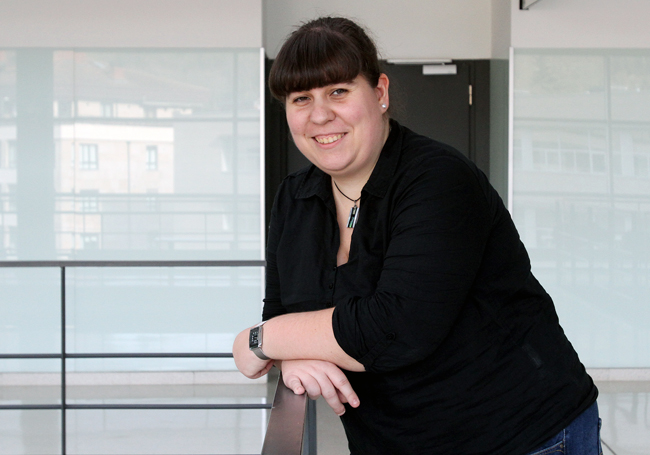Aitziber Mancisidor-Barinagarrementeria, a researcher in the UPV/EHU's Department of Systems Engineering and Automation, has designed a control algorithm for robotic devices rendering them capable of adapting to different recovery statuses of the patients, but without increasing the cost of the device further.
Designing advanced controllers for robotic rehabilitation devices
Robots allow rehabilitation therapies that are more precise and better adapted to the patients’ recovery status to be performed, according to a study by the UPV/EHU-University of the Basque Country
- Research
First publication date: 03/01/2019

In view of the need that has emerged over the last few decades to improve the life quality of patients with reduced mobility, and the progress made thanks to the use of robots in industry, robotic devices have been proposed for rehabilitation therapies. “Rehabilitation robots allow the exercises of a physiotherapist to be emulated, thus offering adapted, precise treatments,” said Aitziber Mancisidor, author of the study. At the same time “they function as a measuring tool allowing strengths and/or movements to be quantified. And with the help of a graphic interface, they build a virtual reality environment to facilitate and promote the rehabilitation process", she added.
Yet owing to their recent introduction into the clinical ambit, many of the areas of rehabilitation robotics have not been studied in depth and there are various aspects in need of improvement, among them the control of the devices. Faced with this situation, this research has concentrated on improving the control component of these robotic devices. “The robot’s mechanical device undertakes to carry out the movements, but if this device is to behave in the desired way, it is essential to design a control algorithm to indicate the strength and frequency with which these movements, etc., need to be performed,” explained Mancisidor.
Capacity to adapt
Any rehabilitation therapy is a long process. At first the patients are unable to generate movement, so the robot has to provide that movement in an appropriate way. Nevertheless, as the patient gradually regains strength, the movement has to be made by the patient him-/herself and the robot has to assist or resist. “In order to meet these needs, a control algorithm divided into two levels has been proposed: firstly, it calculates the assistance the robot has to provide depending on the patient’s recuperation status and the exercise selected; and secondly, it controls the strength and movement exercised by the robot so that smooth, safe movements are generated,” said the UPV/EHU researcher.
At the same time, “the control algorithm designed has been fitted with estimators that allow the position and contact strength between the robotic device and the user to be calculated”, pointed out Aitziber Mancisidor. “One of the problems of robots of this type is that there are very few of them available compared with industrial robots and therefore their cost is very high. To reduce the cost of these rehabilitation devices, we have used various strength and movement estimators rather than expensive sensors,” she added.
Finally, “we have designed and implemented a control and execution platform, which not only allows the control algorithm to be executed in real time, but can also be used as a communication bridge between the rehabilitation robot, the user and the controller. This control and execution platform has enabled various experimental tests of the proposed control algorithm to be made, and this has enabled its functioning to be validated in a range of scenarios.
In view of the results achieved, the researcher concluded that “not only because of their capacity to adapt to different recuperation statuses of the patients but also because of their precision, rehabilitation robots could be a good alternative in future rehabilitation therapies”.
Additional information
This research was conducted as part of the PhD thesis by Aitziber Mancisidor-Barinagarrementeria (Berriatua, 1989), entitled Control avanzado para robótica asistencial y sanitaria [Advanced Control for Assistive and Healthcare Robotics]. It was supervised by Itziar Cabanes-Axpe and Asier Zubizarreta-Pico, lecturers in the UPV/EHU’s Department of Systems Engineering and Automation.
At the same time, while the work was ongoing there was collaboration with the group of UPV/EHU physiotherapists, essential in enabling the solution to be designed with the end users in mind (physiotherapists and patients). Tecnalia is also thanked for its collaboration in lending its UHP robot to validate the algorithms.






